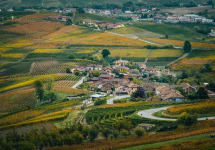Elio Altare Barolo Cannubi 2014



Product Details
Your Rating
Somm Note
Winemaker Notes
Light ruby red with garnet reflections. Fresh to the nose with fresh fruits; rose petals and flowers
Warm and elegant, smooth soft silky tannins.
Other Vintages
2012-
Robert
Parker





Grandfather Giuseppe Altare purchased the farm and winery in 1948, and our family practiced the typical Piemontese mixed agriculture up until the mid-1970s. Besides winegrapes, the family grew pears. apples, hazelnuts, wheat, and corn. 1971 was the last year in which we worked the land with oxen; after that we gradually acquired tractors and other farm machinery.
Those were not easy times, given the economic crisis that lasted for years. Elio, along with other friends, decided to learn about winemaking beyond the borders of Piemonte and try to grab some of the success that those regions were enjoying. Their first trip to Burgundy, in January 1976, was a revelation, and Elio began experimenting with methods outside of the traditional ones in Piemonte
After a brief period working with his father Giovanni, Elio, at the age of 26 years decided to change direction and to give a different interpretation to the family's wine, favouring elegance, finesse, and balance. He began a strict regimen in the vineyard and adopted new vinification techniques in the cantina in order to highlight the grape variety and the territory in which it was grown.
The winery at this point is a family operation, with the invaluable help of Elio's wife, Lucia, and daughters Silvia and Elena. Together, they continue Elio's tireless effort, experimentation, and research.
Today the family works 10 hectares, of which five are rented. They have adopted techniques aimed at respecting nature. The principle objective is that of limiting the use of chemical substances, both in the vineyard and in the cellar. The wines are not subjected to filtering or fining, so that they keep all of the material and character extracted during maceration

Responsible for some of the most elegant and age-worthy wines in the world, Nebbiolo, named for the ubiquitous autumnal fog (called nebbia in Italian), is the star variety of northern Italy’s Piedmont region. Grown throughout the area, as well as in the neighboring Valle d’Aosta and Valtellina, it reaches its highest potential in the Piedmontese villages of Barolo, Barbaresco and Roero. Outside of Italy, growers are still very much in the experimentation stage but some success has been achieved in parts of California. Somm Secret—If you’re new to Nebbiolo, start with a charming, wallet-friendly, early-drinking Langhe Nebbiolo or Nebbiolo d'Alba.

The center of the production of the world’s most exclusive and age-worthy red wines made from Nebbiolo, the Barolo wine region includes five core townships: La Morra, Monforte d’Alba, Serralunga d’Alba, Castiglione Falletto and the Barolo village itself, as well as a few outlying villages. The landscape of Barolo, characterized by prominent and castle-topped hills, is full of history and romance centered on the Nebbiolo grape. Its wines, with the signature “tar and roses” aromas, have a deceptively light garnet color but full presence on the palate and plenty of tannins and acidity. In a well-made Barolo wine, one can expect to find complexity and good evolution with notes of, for example, strawberry, cherry, plum, leather, truffle, anise, fresh and dried herbs, tobacco and violets.
There are two predominant soil types here, which distinguish Barolo from the lesser surrounding areas. Compact and fertile Tortonian sandy marls define the vineyards farthest west and at higher elevations. Typically the Barolo wines coming from this side, from La Morra and Barolo, can be approachable relatively early on in their evolution and represent the “feminine” side of Barolo, often closer in style to Barbaresco with elegant perfume and fresh fruit.
On the eastern side of the Barolo wine region, Helvetian soils of compressed sandstone and chalks are less fertile, producing wines with intense body, power and structured tannins. This more “masculine” style comes from Monforte d’Alba and Serralunga d’Alba. The township of Castiglione Falletto covers a spine with both soil types.
The best Barolo wines need 10-15 years before they are ready to drink, and can further age for several decades.
